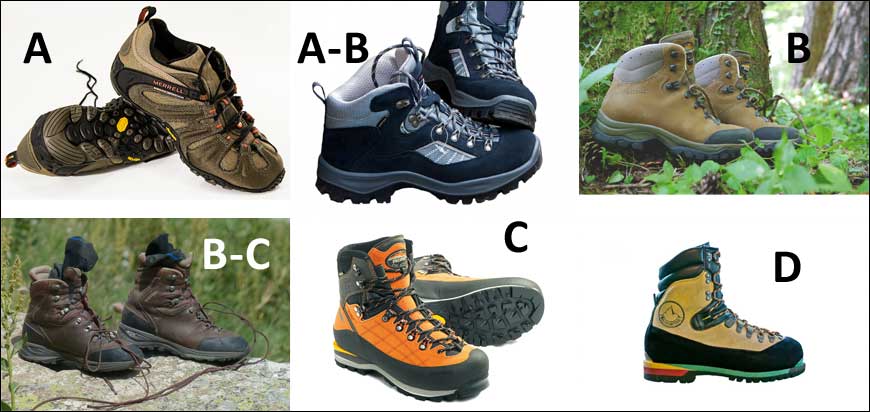It may sound obvious but having happy feet on a hike is one of the ground rules to having an enjoyable experience. However, knowing what you need in terms of footwear is maybe less obvious and with a wide range of footwear for all manner of outdoor activity- how do you know which is the right shoe for you?
In Germany, hiking boots are roughly categorised into an A – D system. Here is our general breakdown of the categories and what you should look for:
A – Hiking shoes
Features:
- Lightweight
- Low-cut (no ankle support)
- Very flexible soles
- Some may be made of goretex or a waterproof material
Ideal for:
- For everyday walking, paved routes, easy day-hikes
AB – Day hiking boots
Features:
- Lightweight
- Mid- to high cut ankle support
- Flexible soles
- May be made of goretex or a waterproof material
Ideal for:
- Day hikes or backpacking with a light or little load
- Prepared and well-trodden hiking routes
B – Hiking boots
Features:
- Sturdier
- Higher cut and stable ankle support
- Stiffer soles with a good profile
- Leather/ goretex / other waterproof material
Ideal for:
- Multi-day hikes with heavier load
- Higher alpine terrain and easy snow field crossing
BC – Trekking boots
Features:
- Sturdier
- Higher cut and stable ankle support
- Rigid soles
- Leather/ goretex / other waterproof material
Ideal for:
- Multi-day hikes with heavy load
- Via ferrata
- High alpine terrain, snow fields
C – Mountaineering boots
Features:
- Rigid boot
- Higher cut and stable ankle support
- Rigid soles
- Leather/ goretex / other waterproof material
- Sole compatible with some types of crampon
Ideal for:
- Difficult trekking and high alpine tours
- Via ferrata
- High alpine terrain, snow fields
- Glacier tours
D – Extreme mountaineering boots
Features:
- Extremely rigid boot
- Higher cut and stable ankle support
- Absolutely rigid soles
- Leather/ goretex / other waterproof material
- Sole compatible with some types of crampon
- Certain models have extra padding for warmth
Ideal for:
- High altitude trekking tours with climbing in mind
- Glacier tours
- Difficult mixed terrain tours
For our hiking events and tours we recommend a category B - C boot.
TOP TIPS FOR BUYING HIKING BOOTS
- In store: As well as good advice, trying on hiking boots before a purchase is an absolute must for getting the right fit
- Take time: Leave plenty of time for the boot-buying process, you will want to walk around in the store for a bit, compare models and fits. Many stores have sample terrain areas for you to trial the shoes
- Go in the afternoon: Your feet swell during the day, giving a more realistic impression of how the boots will feel a few hours into hiking
- Bring your own: Bring whatever you would normally wear on your feet whilst hiking to get the most realistic fit and feel too- whether that's your usual hiking socks or orthapedic insoles
- Staying loyal: If your last boots were a great fit, it is likely that the cut of that brand is a good fit for your foot and makes life a little simpler. However, it’s still worth trying another brand for a comparison
- Break them in: Wear them around the house, office, to/ from work in the time leading up to your first hike to get your feet used to them













